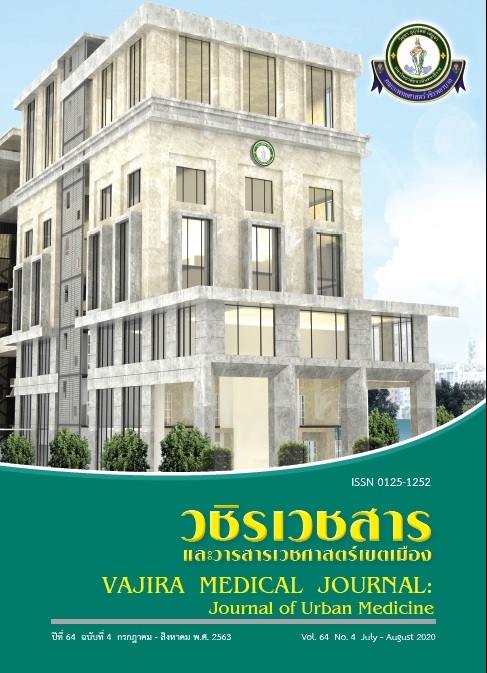Relationship between Serum Ferritin Levels and Biochemical Markers of Bone Turnover in Postmenopausal Women
Main Article Content
Abstract
Objective: To study the relationship between serum ferritin levels and biochemical markers of bone turnover in postmenopausal women.
Methods: This cross-sectional study was conducted at the Department of Obstetrics and Gynecology, Faculty of Medicine Vajira Hospital, Bangkok, Thailand. One hundred and twenty four postmenopausal Thai women were recruited from menopause clinic between December 2015 and March 2016. The inclusion criteria were age 40 years or more, body mass index (BMI) of 19-30 kg/m2, not use menopausal hormone therapy (MHT) within the last 3 months, adequate cessation period of any bone antiresorptive agent, no underlying disease which possibly associated with chronic anemia, and no history of steroid hormone, anabolic agent, or anticoagulant use. The subjects were excluded if their blood specimens were unsuccessfully collected or incompletely analyzed. Two kinds of biochemical markers of bone turnover were selected to study. The first one was a bone-formation marker, called procollagen type I N- terminal propeptide (P1NP) and the second was a bone-resorption marker, namely C-terminal cross-linked telopeptide of type I collagen (CTx). Each marker was evaluated its relationship to serum ferritin.
Results: After recruitment, one subject was excluded because her blood specimen was loss during transfer, therefore 123 cases were left for analysis. Mean (SD) age, BMI, duration of menopause, and number of parity of the overall subjects were 56.8 (4.2) years, 24.3 (3.1) kg/m2, 7.1 (5.3) years, and 1.3 (1.1), respectively. Mean (SD) serum ferritin, P1NP, and CTx levels were 147.75 (95.11), 63.90 (16.70), and 0.463 (0.154) ng/ml, respectively. Serum ferritin levels were negatively correlated with P1NP and with CTx levels (r = -0.149, p = 0.099 and r = -0.038, p = 0.677, respectively).
Conclusion: Serum ferritin levels had non-significant inverse relationship with P1NP and CTx levels in postmenopausal women. The long-term effects of low iron storage on biochemical markers of bone turnover are needed to be further evaluated.
Downloads
Article Details
References
Limpaphayom KK, Taechakraichana N, Jaisamrarn U, Bunyavejchevin S, Chaikittisilpa S, Poshyachinda M, et al. Prevalence of osteopenia and osteoporosis in Thai women. Menopause 2001; 8: 65-9.
Tella SH, Gallagher JC. Prevention and treatment of postmenopausal osteoporosis. J Steroid Biochem Mol Biol 2014; 142: 155-70.
Gómez-de-Tejada Romero MJ, Navarro Rodríguez MD, Saavedra Santana P, Quesada Gómez JM, Jódar Gimeno E, Sosa Henríquez M. Prevalence of osteoporosis, vertebral fractures and hypovitaminosis D in postmenopausal women living in a rural environment. Maturitas 2014; 77:282-6.
Gurevitch O, Slavin S. The hematological etiology of osteoporosis. Med Hypotheses 2006; 67: 729-35.
North American Menopause Society. Management of osteoporosis in postmenopausal women: 2010 position statement of The North American Menopause Society. Menopause 2010; 17: 25-54.
Pongchaiyakul C, Apinyanurag C, Soontrapa S, Soontrapa S, Pongchaiyakul C, Nguyen TV, et al. Prevalence of osteoporosis in Thai men. J Med Assoc Thai 2006; 89: 160-9.
D'Amelio P, Cristofaro MA, Tamone C, Morra E, Di Bella S, Isaia G, et al. Role of iron metabolism and oxidative damage in postmenopausal bone loss. Bone 2008; 43: 1010-5.
Chen Z, Thomson CA, Aickin M, Nicholas S, Van Wyck D, Lewis CE, et al. The relationship between incidence of fractures and anemia in older multiethnic women. J Am Geriatr Soc 2010; 58: 2337-44.
Korkmaz U, Korkmaz N, Yazici S, Erkan M, Baki AE, Yazici M, et al. Anemia as a risk factor for low bone mineral density in postmenopausal Turkish women. Eur J Intern Med 2012; 23: 154-8.
Wright I, Blanco-Rojo R, Fernández MC, Toxqui L, Moreno G, Pérez-Granados AM, et al. Bone remodelling is reduced by recovery from irondeficiency anaemia in premenopausal women. J Physiol Biochem 2013; 69: 889-96.
Cesari M, Pahor M, Lauretani F, Penninx BW,Bartali B, Russo R, et al. Bone density and hemoglobin levels in older persons: results from the InCHIANTI study. Osteoporos Int 2005;16: 691-9.
Laudisio A, Marzetti E, Pagano F, Bernabei R, Zuccalà G. Haemoglobin levels are associated with bone mineral density in the elderly: a population-based study. Clin Rheumatol 2009;28: 145-51.
Salvin HE, Pasricha SR, Marks DC, Speedy J. Iron deficiency in blood donors: a national crosssectional study. Transfusion 2014; 54: 2434-44.
Clark SF. Iron deficiency anemia. Nutr Clin Pract 2008; 23: 128-41.
Jensen PD, Heickendorff L, Helweg-Larsen HM, Jensen FT, Christensen T, Ellegaard J. Serum procollagen III peptide concentration in iron overload. Eur J Haematol 1996; 57: 157-64.
Anker SD, Colet JC, Filippatos G, Willenheimer R, Dickstein K, Drexler H, et al. Ferric carboxymaltose in patients with heart failure and iron deficiency. N Engl J Med 2009; 361: 2436-48.
Polina V, Coriata R, Perkinsa G, Dhoogea M, Abitbola V, Leblanc S, et al. Iron deficiency: from diagnosis to treatment. Dig Liver Dis 2013; 45: 803-9.
Bjarnason NH, Christiansen C. Early response in biochemical markers predict long-term response in bone mass during hormone replacement therapy in early postmenopausal women. Bone 2000; 26: 561-9.
Dogan E, Posaci C. Monitoring hormone replacement therapy by biochemical markers of bone metabolism in menopausal women. Postgrad Med J 2002; 78: 727-31.
Seibel MJ. Clinical application of biochemical markers of bone turnover. Arq Bras Endocrinol Metabol 2006; 50: 603-20.
Lewiecki EM. Prevention and treatment of postmenopausal osteoporosis. Obstet Gynecol Clin N Am 2008; 35: 301-15.
Vasikaran SD. Utility of biochemical markers of bone turnover and bone mineral density in management of osteoporosis. Crit Rev Clin Lab Sci 2008; 45: 221-58.
Garnero P. Bone markers in osteoporosis. Curr Osteoporos Rep 2009; 7: 84-90.


